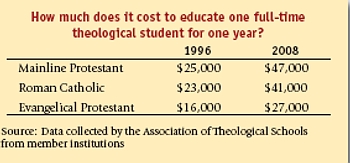
During a recession, conventional economic wisdom says that there is too much capacity for existing consumer demand. Consumer prices fall and profits decline because not enough customers are interested in buying the products that are being made.
While excess production capacity drives down consumer prices, certain fixed costs (like maintaining buildings and paying administrators) cannot be lowered, even if output is reduced. Thus, when sales drop and production declines, the cost to produce each item actually increases.
Theological education has been in a slump for a decade or more. Overall enrollment at member institutions of the Association of Theological Schools was flat for a decade before declining slightly in recent years. Meanwhile, the number of schools has increased! It's not surprising that most schools have excess capacity. That is, they could enroll more students with the same number of faculty, administrators, and buildings.
While the overall number of students at ATS schools has declined slightly, expenses at most schools have not. Salaries have climbed; new technologies have demanded capital improvements; utility costs have grown.
As in the manufacturing sector, excess capacity exerts downward pressure on prices. In theological education, "lower prices" usually means tuition discounting - financial aid that sometimes extends to most of the student body.
 |
| Evangelical schools, with larger average student bodies, have correspondingly lower per-student costs. |
As a result, the cost per student is very high, while students pay only a fraction of what their education actually costs.
Now more than ever, it is vital for theological schools to pay attention to the issue of excess capacity. Unless the board and administration are very clear about their institutional reality and creative in exploring ways to address the gap between capacity and demand, there can be no long-term financial viability for an institution. Quick-fix cost-cutting is clearly not the appropriate answer - especially if what is truly called for is a reorientation that brings capacity and demand into alignment.
Outmoded measures of quality?
Traditionally institutions of higher education have used a variety of indicators of quality:
■ Admission. The percentage of applicants who are admitted.
■ Matriculation. Percentage of admitted applicants who enroll.
■ Graduation. Percentage of enrolled students who earn a degree within a set number of years.
■ Student/faculty ratio.
■ Financial aid. The amount of aid either available or delivered.
■ Discounted tuition. The ultimate cost that a student pays for a full-time year of schooling.
■ Faculty terminal degrees. Percentage of faculty with doctoral (or other final) degrees.
■ Recognition. Faculty awards and other external acknowledgment of school quality.
These traditional marks of quality are based on assumptions that are increasingly outmoded. For example, they assume a norm of full-time students taking classes during the daytime, Monday through Friday. They assume that a meritorious student finishes coursework in the allotted time and remains in one institution until the degree is earned. They assume that full-time professors write award-winning books during nonteaching hours.
As a result, programs with large numbers of "nontraditional" students appear to lack quality, and faculty who don't win awards but who teach as many as eight courses per year appear less prestigious than faculty who teach three courses per year and thus have time to publish.
Excess capacity
The indicators of institutional capacity are quite different from the traditional marks of "quality." In the business world, capacity is related to productivity - using resources effectively to create more "product." It is measured by yardsticks like return on equity, return on investment, and earnings per share.
While it is true that theological schools are not exactly like businesses, it seems to me that schools do not think or talk often enough about the cost of the educational "product" and whether the product matches the demands of the marketplace. But when a school has excess capacity, especially in a time of economic stress, a responsible board and administration cannot avoid the difficult discussion. Increasing a school's income streams may not be possible. Changing the cost structure through new educational models - or changing the way in which the school packages and delivers its product - may be the only options.
What are a board and administration to do when challenged by excess capacity? First, face all the facts: look with clarity and steadfastness at the school's mission, its capacity, and the quality of its outcomes.
Achieve clarity of mission
Easily said, but hard to do. Yet organizations that succeed know exactly what they are about. They understand whom they serve. And they demonstrate a deep level of commitment to deliver that service with consistent quality. Knowing and owning a mission provides a bond among an institution's members from top to bottom and energizes them to fulfill that mission together.
To understand educational capacity, leaders of an institution must first know what they are trying to achieve. Asking four basic questions can help to clarify the mission, the vision to make that mission concrete, the strategy to achieve it, and the assessment of whether the institution is successful in fulfilling it.
Who are we? What defines us? What motivates us? Gaining clarity about this requires a community of openness and a willingness to engage with others around the fundamental hopes that bring the community together. Engaging and digging releases the energy and builds the commitment that drives the community.
What do we do? Broadly speaking, theological schools provide educational programs designed to prepare persons for ministry and serve as theological resources to the church and the world. Their primary means of delivery is courses, some consultation and participation in external and internal events, and research and publications.
For whom do we do what we do? Each product and delivery system should have an intended audience. It's useful to ask what the audience actually wants and needs to learn and what setting and method can best deliver educational product with quality and efficiency.
What benefit do they receive from this educational experience? Too often, educational institutions and their programs fail to ask this question and to discern carefully the results. They tend to stop with merely assessing and promoting their product, not asking whether and how it serves.
Quality in outcomes, not just outputs
Boards, administrators, and faculty of every school should come to an agreement on measures of quality, feeling confident that these measures truly reflect the institution's mission and core values. But schools often struggle to find external reference points or standards by which to determine quality.
The traditional reference points - faculty/student ratio, terminal degrees, scholarship aid, library resources, and others, are relatively easy to measure. But they are "outputs" - the product that the school provides.
It's more useful, but more difficult, to assess "outcomes" - the results that an institution hopes to achieve in collaboration with the student. Thus, most schools measure the student/teacher ratio without asking how class size actually affects student learning. Institutions seek faculty with terminal degrees without measuring whether more doctorates help a school achieve its mission.
To focus on "outcomes" (student learning) rather than "outputs" (the educational products that have been delivered to students) sometimes means rethinking an entire system of measuring effectiveness. Assessing the quality of outcomes is far more difficult than assessing outputs.
Quality and accreditation
In the 1990s, the Association of Theological Schools revised its accrediting standards. These revisions were made in recognition of the diversity of the member institutions with their unique missions. Consequently, the revisions demanded that quality be assessed not on external qualities like the size of the library or number of faculty with Ph.D. degrees, but on clarity of mission and the ability to fulfill that mission in a particular religious tradition and context.
In light of the new accreditation standards, understanding what creates effective pastoral leadership and how to educate and form persons to be effective pastors became the central qualitative concern for seminaries.
Assume for a moment four categories necessary for effective pastoral leadership:
Character. A person's identity, and how that person interacts with and affects others.
Competence. The knowledge and ability to perform in required ways - especially to influence individuals and groups.
Contribution. The gifts that a pastoral leader makes to individuals, the community, and the church -the fruits of ministry.
Context. The environment in which the pastoral leader uses this character, competence and contribution - the particular setting for ministry, whether congregation, service or mission organization, seminary, or secular setting.
The goal of theological education is to educate and form competent leaders of strong character who can contribute in particular contexts. Thus, the heart of the issue of quality is how successfully a seminary performs the task of forming such leaders. It is an enormously complex and challenging task. The variables are multiple. There is no one model or method that guarantees success.
But that is the core mission of a theological school. And addressing the problem of excess capacity while maintaining high quality must always be done in light of the core mission.
Technology, teaching, and learning
Onsite educational costs are rising, but information technology also is pushing higher education to rethink teaching and learning. In a recent article in the Washington Post, Zephyr R. Teachout wrote:
Students starting to school this year may be part of the last generation for which ‘going to college’ means packing up, getting a dorm room, and listening to tenured professors. Undergraduate education is on the verge of a radical reordering. Colleges, like newspapers, will be torn apart by new ways of sharing information enabled by the Internet. The business model that sustained private U.S. colleges cannot survive (“A Virtual Revolution is Brewing for Colleges,” September 13, 2009).
This revolution is sweeping over theological education as well. Already, a majority of theological students do not live on campus and are not full-time. Though many seminaries have already jumped into distance learning, most schools have not yet committed to aggregation — that is, using outside, electronically delivered basic courses. Each seminary still believes it must teach its own version of New Testament 101, even if to a few students.
Questions to ask about educational capacity
■ How can capacity be measured at our theological school? What are its components?
■ How do we and those whom we serve define quality? How do we measure it?
■ What are the norms or standards for capacity and quality? What are the benchmarks? What are the points of comparison with other theological schools - and especially with our competitors?
■ In our theological school, what is our decision-making process for addressing issues of capacity? What is the board's appropriate role in this process? The faculty's role? Can we use the various governance structures that are already in place to make decisions about capacity, or do we need new structures?
These questions address the fundamental issues for any school - its mission, educational design, staffing, facilities, assessment, financial equilibrium, and governance. Answering them is governance work, which requires a cooperative effort by the board, the administration, and the faculty.